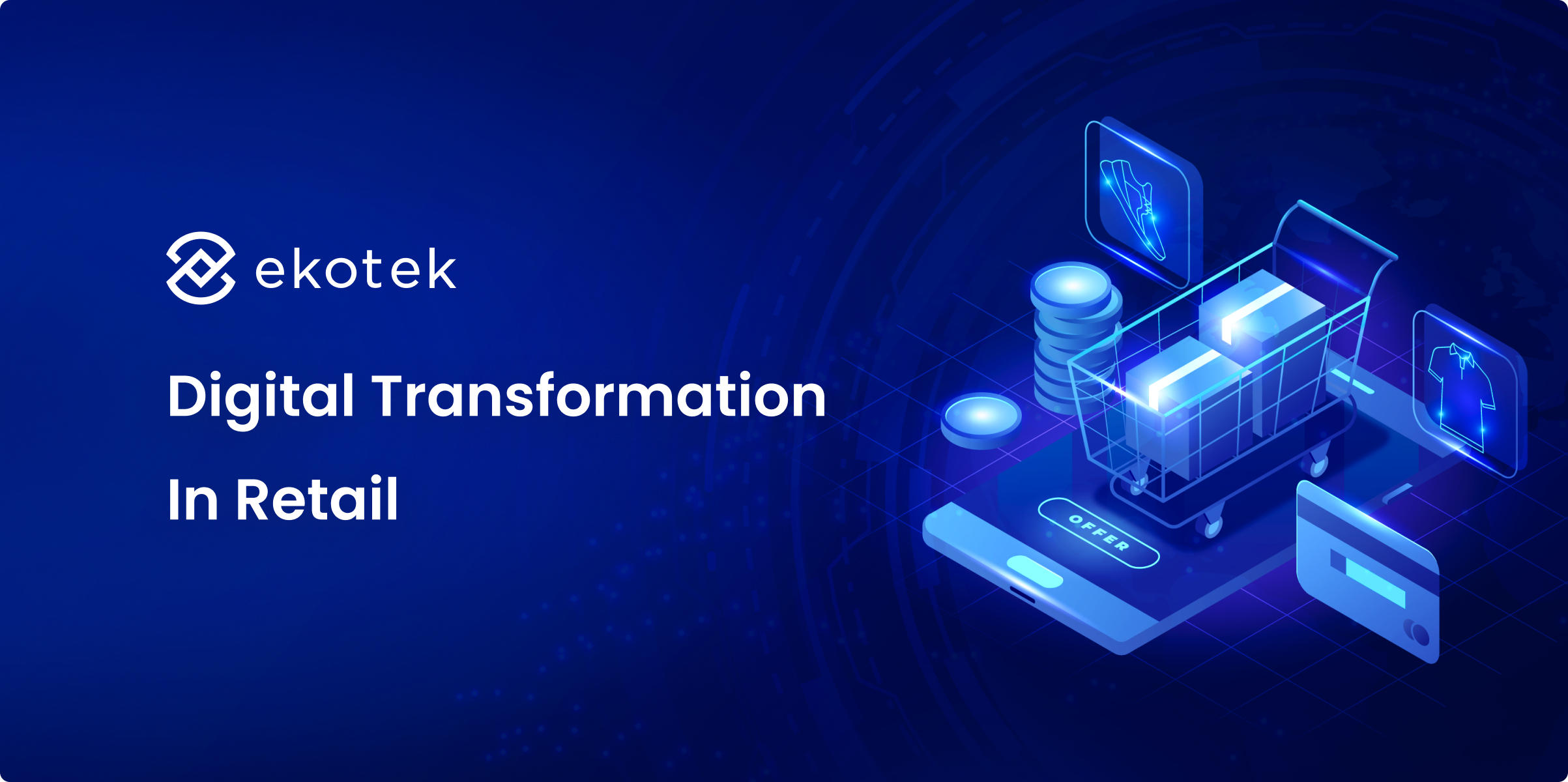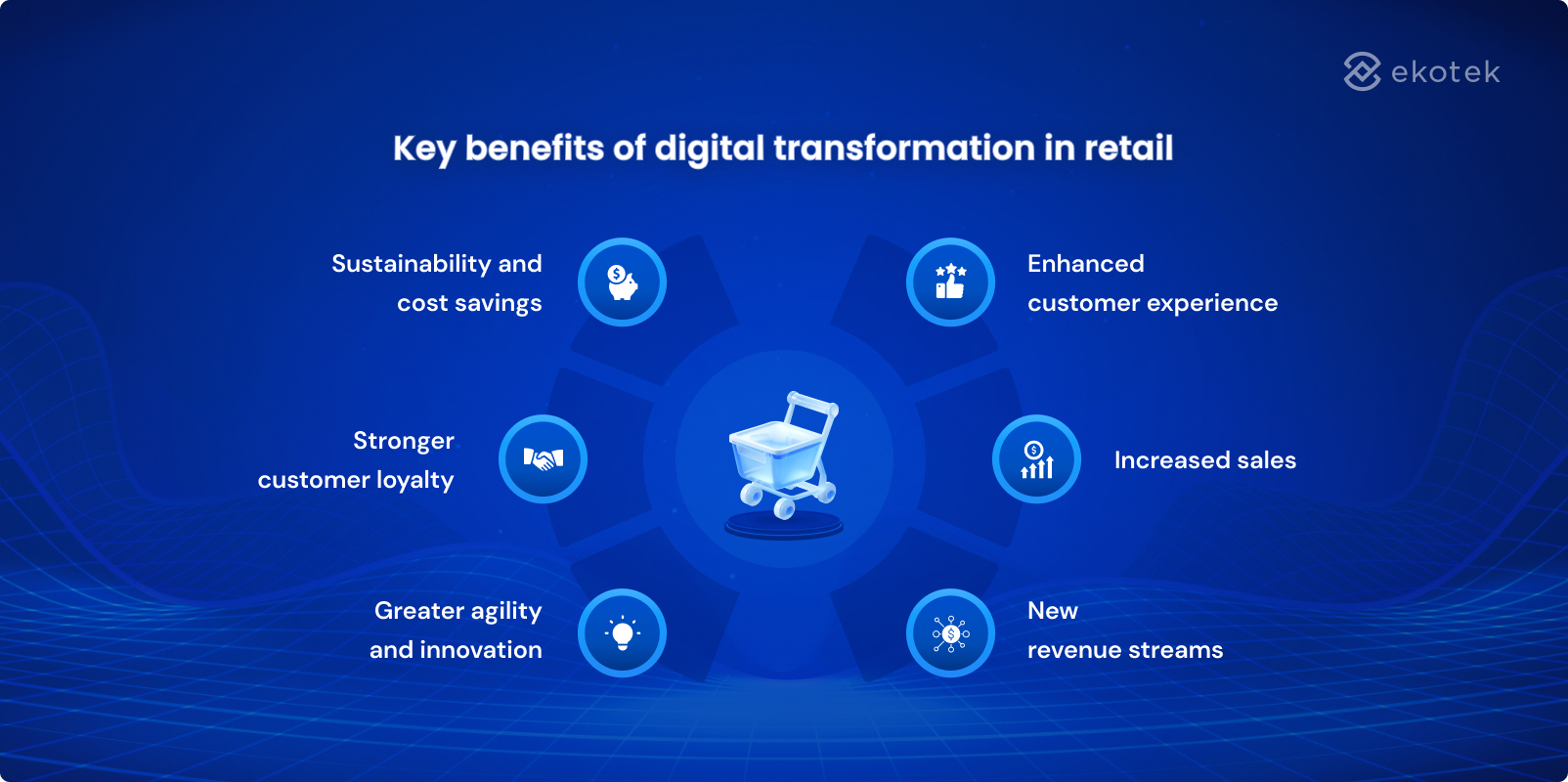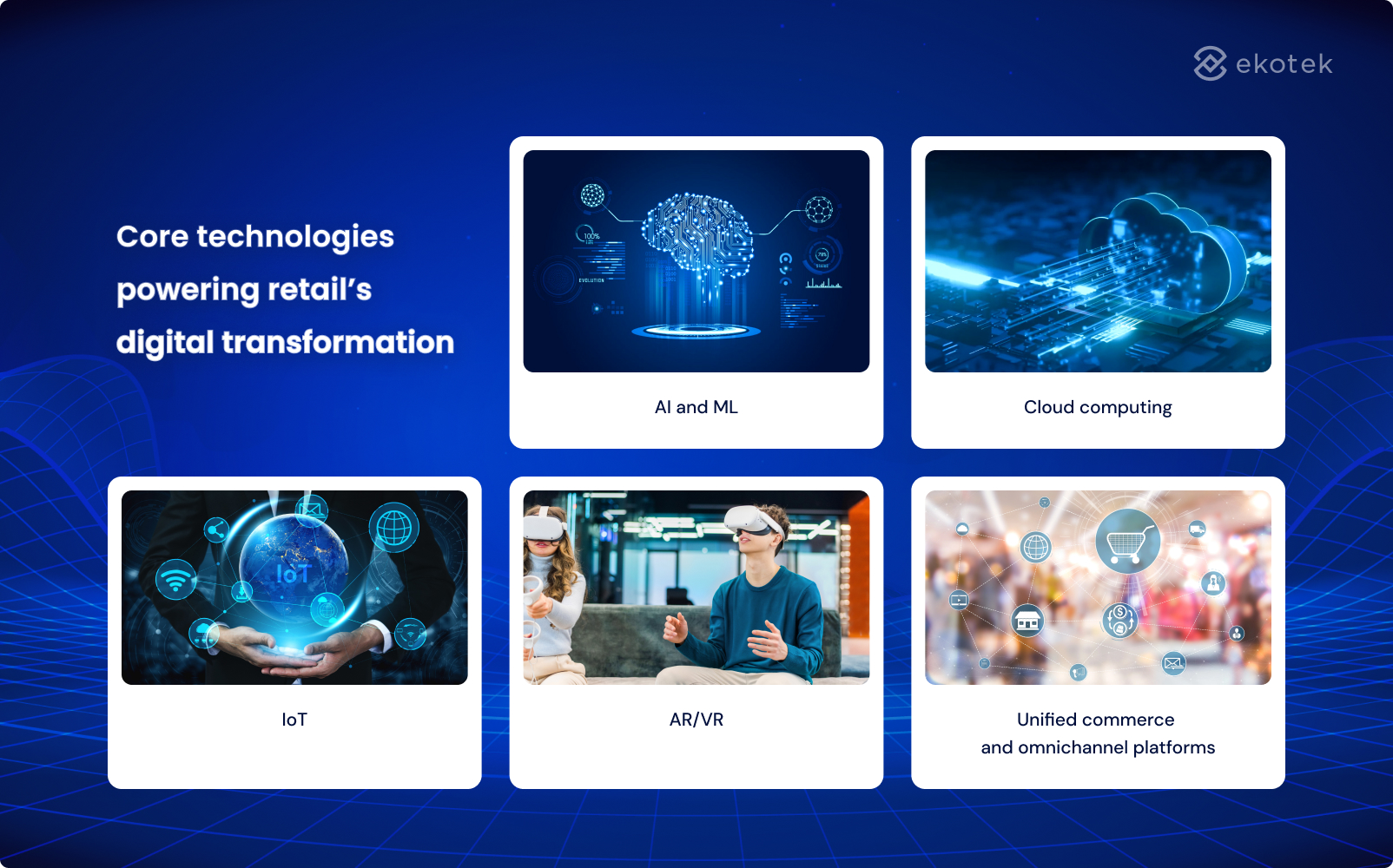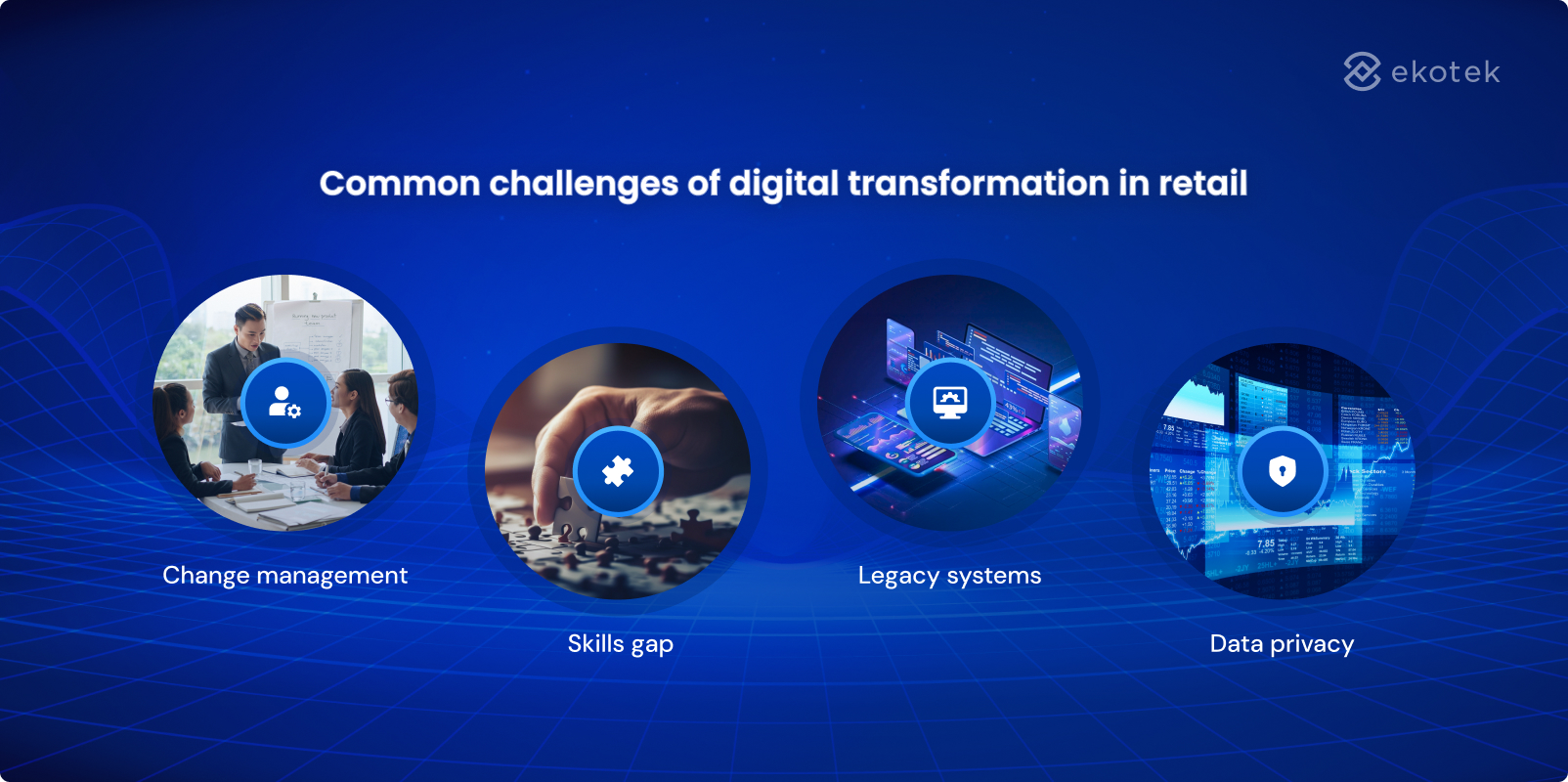
- 1
- 2
- 3
- 4
- 5
- 6
- 7
- 8
- 9
- 10
Introduction
The retail industry has undergone a seismic shift in recent years. According to a report from McKinsey, global e-commerce grew by 27% in 2020 alone, and consumer expectations for seamless digital experiences are now higher than ever. Meanwhile, over 70% of customers expect personalized experiences across every channel – online and offline.
To meet these demands, more and more retailers are turning to digital transformation in retail, a holistic approach to modernizing their business models, technologies, and customer experiences.
In this blog, we’ll explore what digital transformation in retail really means, its key benefits for retailers, inspiring case studies, and a practical roadmap to help you start your own transformation journey.
Understanding digital transformation in retail
At its core, digital transformation in retail refers to the strategic adoption of digital technologies to enhance business processes, improve customer experiences, and create new value. It’s not just about adding a mobile app or launching an online store, it’s about rethinking how your business operates in a digital-first world.
It’s important to distinguish digitization from digital transformation, as they are not the same. Digitization simply means converting analog information or processes into digital form, for example, replacing paper receipts with e-receipts, or scanning inventory into a digital database.
In contrast, digital transformation is about rethinking the entire business model using technology. For instance, creating an omnichannel retail experience where customer data flows across online stores, loyalty programs, and physical stores, enabling personalized offers, real-time inventory updates, and consistent engagement at every touchpoint.
| Aspect | Digitization | Digital Transformation |
|---|---|---|
| Definition | Converting analog processes or data into digital formats | Reimagining the entire business model and operations using digital technologies |
| Focus | Tools and individual processes | Strategy, culture, customer experience, and operations |
| Scope | Narrow, specific processes | Broad, impacts the entire organization |
| Goal | Improve efficiency of existing processes | Drive innovation, enhance customer value, and gain competitive advantage |
| Change level | Operational improvement | Business model transformation |
Why digital transformation is no longer optional for retailers
 Consumer behavior shifts
Consumer behavior shifts
Today’s consumers expect a seamless omnichannel experience, switching effortlessly between online and offline channels. They also demand personalized interactions, and brands that fail to deliver risk losing engagement and loyalty.
Rise of digital-first competitors
Agile digital-to-consumer brands like Glossier and Allbirds are winning market share with fast, tech-driven customer experiences. Traditional retailers must embrace digital transformation to stay competitive in this rapidly evolving landscape.
Operational efficiency and resilience
Digital tools enable retailers to build more resilient supply chains and automate key operations. This drives cost savings and allows faster responses to market disruptions or changing consumer demand.
Data-driven insights for smarter decisions
Retailers today can tap into rich customer data to guide smarter decisions on inventory, marketing, and product development. Those who leverage data effectively gain a significant competitive advantage.
⭐️ You might be interested in Digital Transformation In Manufacturing
Key benefits of digital transformation in retail
 Enhanced customer experience
Enhanced customer experience
Digital tools allow retailers to deliver a seamless, personalized experience across all channels, online, mobile, and in-store. This creates a smoother buying journey, increasing customer satisfaction and encouraging repeat business.
Increased sales
By leveraging personalized recommendations, targeted marketing, and omnichannel shopping options, retailers can boost conversion rates and average order values. A more engaging and convenient shopping experience also attracts new customers.
New revenue streams
Digital transformation enables retailers to explore new business models, such as subscription services, digital marketplaces, or experiential retail. These additional revenue streams help diversify income sources.
Ekotek implemented a blockchain-based digital authenticity solution for a client in the F&B and retail sector. This allows consumers to verify whether a beverage product is genuine, enhancing trust and product transparency. Beyond product authentication, the solution also provides valuable consumer insights, such as purchase preferences, enabling the client to develop new data-driven business models and run personalized marketing campaigns. This not only protects brand reputation but also opens up new monetization opportunities based on first-party data
Greater agility and innovation
Digitally mature retailers can quickly adapt to changing market trends and consumer behaviors. They are also better positioned to test and launch new products, services, and business models.
Stronger customer loyalty
Consistent, personalized engagement, whether through loyalty programs, tailored offers, or exceptional service, helps retailers build deeper relationships with their customers. Loyal customers are more likely to return and advocate for the brand.
Sustainability and cost savings
Data-driven optimization helps retailers reduce waste (such as excess inventory or energy use). Digital processes also cut down on paper, packaging, and unnecessary logistics, supporting both cost savings and sustainability goals.
Core technologies powering retail’s digital transformation
 AI and Machine Learning (ML)
AI and Machine Learning (ML)
AI and ML enable retailers to analyze vast amounts of customer data to deliver personalized product recommendations, targeted marketing, and dynamic pricing. They also power AI chatbots that provide fast, 24/7 customer support and handle routine inquiries, freeing up human agents for more complex tasks.
⭐️ Explore how Ekotek built an AI chatbot to help an e-commerce company deliver faster, more efficient customer support.
Cloud computing
Cloud platforms provide scalability and flexibility, allowing retailers to quickly deploy new applications, manage data across all channels, and support real-time analytics. By reducing the need for costly on-premises infrastructure, cloud computing lowers IT costs while enabling faster innovation. A significant 80% of retailers are either using or planning to use cloud computing for various operations, with 83% experiencing improved IT agility and scalability through its adoption
IoT (Internet of Things)
IoT devices, such as smart shelves, beacons, and RFID tags, provide real-time visibility into inventory levels, product movement, and customer behavior in stores. This helps retailers optimize stock management, improve in-store experiences, and enable services like automated checkout.
AR/VR (Augmented Reality/Virtual Reality)
AR and VR technologies create immersive shopping experiences, allowing customers to virtually try on clothes, visualize furniture in their homes, or explore virtual showrooms. These tools enhance engagement and reduce return rates by helping shoppers make more confident purchase decisions. Moreover, 56% of consumers reported that AR technology increases their confidence in a product’s quality, and 61% preferred shopping at retailers that provide AR experiences
Unified commerce and omnichannel platforms
Unified commerce platforms connect point-of-sale (POS), online stores, mobile apps, marketplaces, and social channels into a single, integrated system. This enables seamless customer experiences. For example, allowing shoppers to buy online and pick up in-store, check real-time inventory across locations, or return items through any channel.
Real-world examples: Retailers winning with digital transformation
Walmart – Driving efficiency and customer convenience through AI and automation
Walmart is a global leader in leveraging digital transformation to enhance both customer experience and operational efficiency. The company has invested billions of dollars into AI, automation, and omnichannel initiatives to stay competitive.
- The Walmart mobile app integrates with in-store experiences, allowing customers to locate items, check inventory, and use mobile checkout for convenience.
- AI-powered demand forecasting helps optimize inventory and reduce stockouts across stores.
- Robotic Process Automation (RPA) and automated fulfillment centers have streamlined logistics and sped up delivery and order processing.
- Walmart also uses machine vision for shelf scanning and in-store stock monitoring, improving real-time inventory accuracy.
Target – Seamlessly blending online and offline retail experiences
Target has successfully transformed into an omnichannel retail leader, blending online and in-store experiences seamlessly.
- They introduced same-day pickup and drive-up services, where customers can order online and collect their purchases without leaving their vehicles.
- Through partnerships with Shipt, Target offers same-day home delivery, significantly expanding its last-mile fulfillment capabilities.
- Target has integrated inventory data across its website and stores, allowing customers to see real-time stock availability online.
As a result, Target has reported record growth in digital sales over the past several years, especially during and after the COVID-19 pandemic.
Roadmap to start your digital transformation journey
 Assess your current digital maturity
Assess your current digital maturity
Start by evaluating where your organization stands today in terms of digital capabilities. Assess technology infrastructure, data usage, digital processes, and team readiness. This baseline will help identify strengths, weaknesses, and opportunities.
⭐️ You’ll need our Enterprise digital readiness check ebook for your assessment
Define clear business goals
Digital transformation should always align with business objectives. Are you aiming to improve customer experience? Increase operational efficiency? Drive new revenue streams? Set measurable goals that will guide your initiatives.
Develop a customer-centric vision
Put the customer at the heart of your transformation strategy. Map customer journeys, gather insights from customer feedback, and identify pain points that can be addressed through digital solutions.
Invest in the right technologies
Select technologies that directly support your business goals, whether it’s AI, cloud computing, advanced analytics, or automation. Avoid “technology for technology’s sake” by focusing on solutions that add real value.
Leverage external partners
Successful digital transformation requires a combination of internal knowledge and external expertise. While it’s important to build cross-functional teams internally, many companies accelerate their journey by collaborating with specialized partners.
Outsourcing digital transformation services can provide technical know-how, implementation experience, and strategic guidance, helping you avoid common pitfalls and speed up execution.
⭐️ You may need our Software outsourcing vendor evaluation guide
Start with pilot programs
Rather than launching large-scale initiatives all at once, begin with focused pilot projects. Test new technologies and processes in a controlled environment, learn from early results, and make adjustments before scaling up.
Measure progress and iterate
Establish key performance indicators (KPIs) and continuously track progress. Use data to learn what’s working and what isn’t. Be prepared to iterate and refine your approach as you gain new insights.
Scale and continuously innovate
Once successful pilots are validated, scale them across the organization. Foster a culture of continuous innovation by encouraging experimentation, learning, and agility to adapt to market changes.
Common challenges and how to overcome them
 Change management
Change management
Digital transformation often fails not because of technology, but due to resistance to change. Leaders must actively champion the transformation, communicate a clear vision, and foster a culture where experimentation and innovation are encouraged.
Skills gap
Many organizations lack the necessary digital skills internally. A dual approach works best: upskill current employees through targeted training, while strategically partnering with external experts or hiring specialized talent to fill critical gaps.
Legacy systems
Legacy systems can slow transformation and create data silos. Using API-first or microservices architectures enables modern applications to interoperate with existing systems, allowing gradual modernization without major disruption.
⭐️ See how Ekotek successfully migrated a logistics company legacy system
Data privacy
As digital initiatives grow, so do data privacy and security concerns. Companies must establish strong data governance frameworks and ensure compliance with regulations like GDPR, while embedding security considerations into every stage of their digital projects.
Future trends shaping digital transformation in retail
AI-powered hyper-personalization
AI-driven personalization is moving beyond basic product recommendations to real-time, 1:1 interactions across all touchpoints, web, mobile, email, and even in-store. Leading retailers are leveraging AI to tailor content, pricing, and promotions based on individual customer behavior and preferences.
⭐️ Learn more about AI integration
Blockchain-enabled supply chain transparency
Blockchain technology is helping retailers build transparent, verifiable supply chains, critical for meeting growing consumer demand for ethical sourcing and sustainability. A 2023 IBM study found that 71% of consumers are willing to pay a premium for brands that provide full traceability. Blockchain can verify product origin, track environmental impact, and authenticate luxury goods or limited-edition items.
Metaverse and virtual commerce
The metaverse is creating new digital storefronts and immersive shopping experiences. Forward-thinking retailers are experimenting with virtual try-ons, branded virtual worlds, and NFTs to engage younger, digital-native consumers.
⭐️ Explore other digital transformation trends in 2025
Conclusion
Digital transformation in retail is no longer a luxury, it’s the key to survival and future growth. Retailers that embrace change will be better positioned to deliver superior customer experiences, drive efficiency, and stay competitive.
Partnering with an experienced digital transformation provider can accelerate your journey and help you avoid common pitfalls. Ekotek brings deep expertise in retail transformation, from consulting and solution design to full-cycle product development and ongoing support. Whether you’re modernizing legacy systems, building personalized customer experiences, or scaling new digital channels, Ekotek is ready to help you turn vision into measurable business outcomes.
👉 Contact Ekotek today to explore how we can support your digital transformation journey and future-proof your retail business.
- 1
- 2
- 3
- 4
- 5
- 6
- 7
- 8
- 9
- 10